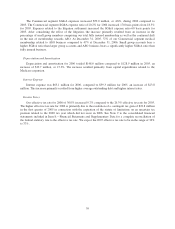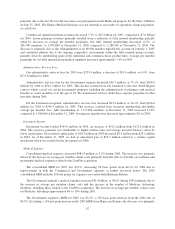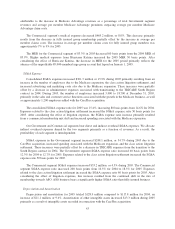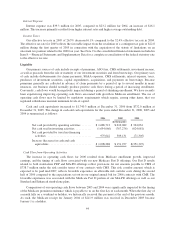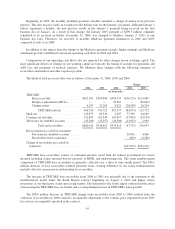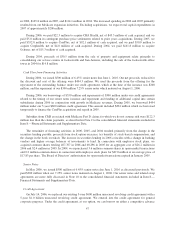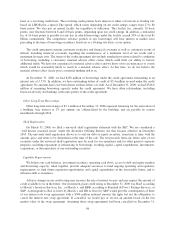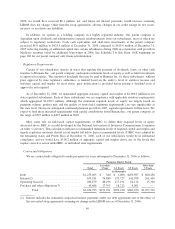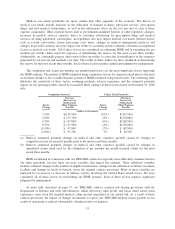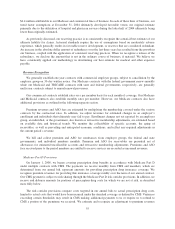Humana 2006 Annual Report Download - page 57
Download and view the complete annual report
Please find page 57 of the 2006 Humana annual report below. You can navigate through the pages in the report by either clicking on the pages listed below, or by using the keyword search tool below to find specific information within the annual report.
Beginning in 2005, the monthly premium payment schedule included a change in timing from previous
practice. This new practice made an exception to the holiday rule for the January 1 payment. Although January 1
always represents a holiday, the new practice results in the January 1 payment being received on the first
business day of January. As a result of this change, the January 2005 payment of $290.3 million originally
scheduled to be received on Friday, December 31, 2004, was changed to Monday, January 3, 2005, or one
business day later. Therefore, we received 12 monthly Medicare premium remittances in 2006 and 2005,
compared to only 11 in 2004.
In addition to the impact from the timing of the Medicare premium receipts, higher earnings and Medicare
enrollment growth contributed to increased operating cash flows in 2005 and 2004.
Comparisons of our operating cash flows also are impacted by other changes in our working capital. The
most significant drivers of changes in our working capital are typically the timing of receipts for premiums and
ASO fees and payments of medical expenses. We illustrate these changes with the following summary of
receivables and medical and other expenses payable.
The detail of total net receivables was as follows at December 31, 2006, 2005 and 2004:
Change
2006 2005 2004 2006 2005
(in thousands)
TRICARE:
Base receivable ................... $452,509 $509,444 $396,355 $(56,935) $113,089
Bid price adjustments (BPAs) ........ — — 25,601 — (25,601)
Change orders .................... 4,247 32,285 6,021 (28,038) 26,264
TRICARE subtotal ............ 456,756 541,729 427,977 (84,973) 113,752
Medicare ............................ 143,875 66,536 2,287 77,339 64,249
Commercial and other .................. 125,899 162,944 183,857 (37,045) (20,913)
Allowance for doubtful accounts ......... (45,589) (32,557) (34,506) (13,032) 1,949
Total net receivables ........... $680,941 $738,652 $579,615 (57,711) 159,037
Reconciliation to cash flow statement:
Provision for doubtful accounts ...... 20,901 4,566
Receivables from acquisition ........ (843) (2,289)
Change in receivables per cash flow
statement .......................... $(37,653) $161,314
TRICARE base receivables consist of estimated amounts owed from the federal government for claims
incurred including claims incurred but not reported, or IBNR, and underwriting fees. The claim reimbursement
component of TRICARE base receivables is generally collected over a three to four month period. The $56.9
million decrease in base receivables resulted primarily from a timing difference in our claim reimbursements
partially offset by an increase in underwriting fee receivables.
The increase in TRICARE base receivables from 2004 to 2005 was primarily due to the transition to the
reimbursement model under the South Region contract beginning on August 1, 2004 and higher claims
inventories at our third party claims processing vendor. The transition to the South region contract had the effect
of increasing the TRICARE base receivable and a corresponding increase in TRICARE claims payable.
The $28.0 million decrease in TRICARE change order receivables from 2005 to 2006 resulted from the
collection of receivables in 2006 related to an equitable adjustment to the contract price negotiated in late 2005
for services not originally specified in the contract.
45






